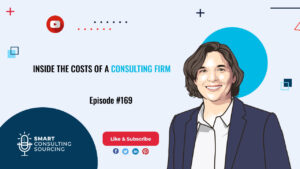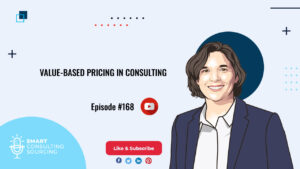Hello and welcome to episode 50 of our podcast: Smart Consulting Sourcing, THE podcast about Consulting Procurement.
My name is Hélène, and I’ll be your host today.
Each week I’ll give you the keys to better use, manage and source consulting services.
This week, I’ll explain How the Right Compensation Model Benefits a Project?
Last week, I gave you 5 reasons why Executives love to hate consultants.
We saw that building a solid consulting Procurement capability and measuring your Providers’ Performance (and acting on it) will increase your teams’ satisfaction when working with Consultants and positively impact the return on investment of your Consulting Projects.
Compensation Model and Fee structure
Compensation models vary, and using the right one can benefit both parties, Clients, and Consultants, and ensure everyone is happy and gives their best to the project.
Every project is different, so choosing the best Compensation model can greatly impact the ROI of the project. To maximize the benefits, take the time to evaluate and select the Compensation model you think is right for you and your organization.
Now let’s dive into the most used Compensation model and see how you can make your dream project happen while properly compensating your Consultants.
Here is how this works – If you want to optimize your consulting spend, you might be tempted to attack the cost base with traditional cost-cutting measures (reducing budgets, negotiating discounts, setting up multiple validations, etc.).
Even though this can provide short-term results, we should not lose sight that using consultants is about value creation. As such, despite all the bad press about consultants and their fees, discussions should primarily be about impact and value.
1- Deliverable-based fees or flat fee
Most Consulting firms use the flat fee structure for their projects. The Consultant will evaluate the work to be done and staff a little team. The total fee will reflect the total cost of the team to provide the work.
Pros: The Consulting team will do the work even if the workload is higher than expected. The risk for the Client is limited. The incentives for the Consultants are through repeat business and resource optimization.
Cons: But the Client pays the amount agreed, even if the consulting team does the work faster than expected. The Consultant can be tempted to “supercharge” their resources to mitigate the risks. The Consultant can allocate resources to the proposal that will never work on the project to create a buffer.
2- Time-based fees or daily rates
This system is very common, in particular with small projects and independent consultants. It can also apply to interim management assignments. The Consultant will define a daily rate and invoice the Client based on the number of days actually worked for the Client.
Time-based fees will be perfect for projects where you mostly need extra arms and legs, such as interim management or spot team reinforcement.
Pros: The Client will only pay for the work done and time spent. This fee structure is particularly transparent and adapted to projects with a finite duration.
Cons: But on the downside, a low-performing consultant will charge more days. Besides, the incentives for the Consultants are to stay longer to charge more. And what happens if you are not available and the work cannot progress as planned? The Client has little control over the total cost of the project. The risk is mostly on the Client’s side.
3- Retainer-based fees
When a client needs continuous part-time support, they can opt for retainer-based fees. The Consultant and the Client agree on several days per week/month/quarter where the Consultant will be on “stand-by.” The retainer can be paid in a lump sum or monthly, independently of the work done by the Consultant.
Pros: The Consultant has to stay on top of the Client’s organization and priorities. The Client is sure to have access to the Consultant for the agreed period. This type of model works particularly well when deliverables are unclear and can change during the assignment.
Cons: But the consultants can have several projects at the same time. The “retainer” client is not always their #1 priority as that project is secured. Some consultants tend to consider retainers as paid commercial time.
4- Value-based Pricing
Value-based pricing is a pricing strategy where the prices are set not on time and materials or cost + margin, but rather on the perceived value for the Client of the service delivered. For Consulting services, it could be a share of the savings realized in a cost-cutting project.
Pros: The clients and the consultants share the same interests: the more value created, the more value for each party. The risk for the Client is very limited. THey only have to commit to a small flat fee.
Cons: However, the baseline and the conditions of success have to be defined very precisely so the Client doesn’t end up paying more than the value really created. The model is more difficult to apply for intangible deliverables with no direct, measurable impact on the P&L.
Traditional consultancies are reluctant to use this fee structure that does not fit their pricing and risk management models (you cannot book a team of four consultants from the pool when the payment for only two can be secured).
Let’s take a few minutes to dive into this value-based pricing.
More and more consultancies are exploring ways to share the value with their clients. The movement started with Bain & Company when they moved from pure strategy work to more operational support.
Value-sharing fees make sense when the stakes are high, and you expect the consultants to go above and beyond their normal delivery by aligning their interests with yours and giving them, beyond the sole repeat business, the perspective of a substantial upside in case of success.
Typical projects will include cost-saving programs, pricing optimization, and a new business launch. To mitigate the risks, you will have to implement governance to ensure the activities (and how they are performed) remain in line with your overall strategy and culture.
Indeed, the consultants will take a very active role in the execution of the project, but you stay at the helm. And what are the expectations beyond their normal job that would justify a special bonus?
The catch, when using value-sharing, is to define clearly the starting point and the parameters involved in the measure.
In conclusion, you can identify the fee structures that will yield more value for your company for each project. It will depend on the type of project, the nature of the deliverables, the context of the project, the flexibility you have on fees, and the level of commitment you expect from the Consultant.
That’s it for today. Next time, I’ll talk about 6 Great Advantages of the Gig Economy and the impact for consulting clients.
In the meantime, if you have any questions, or want to learn more about what we do at consulting quest, just send me an email at helene.laffitte@consultingquest.com
You can also have a look at our website smartconsultingsourcing.com to know more about our book and download free templates & guides to improve your consulting sourcing.
Bye and see you next week! Au revoir!







